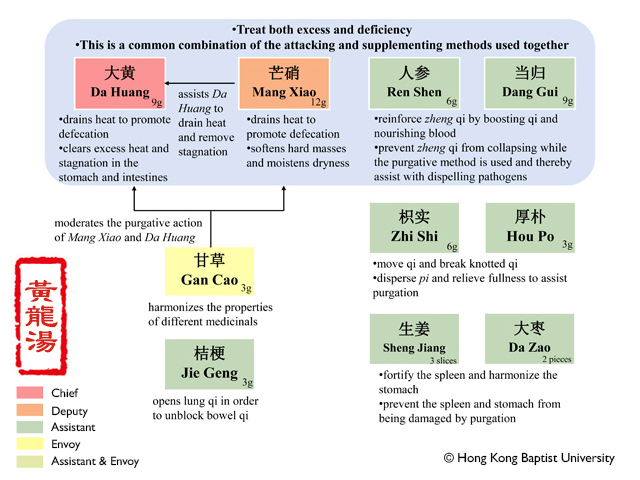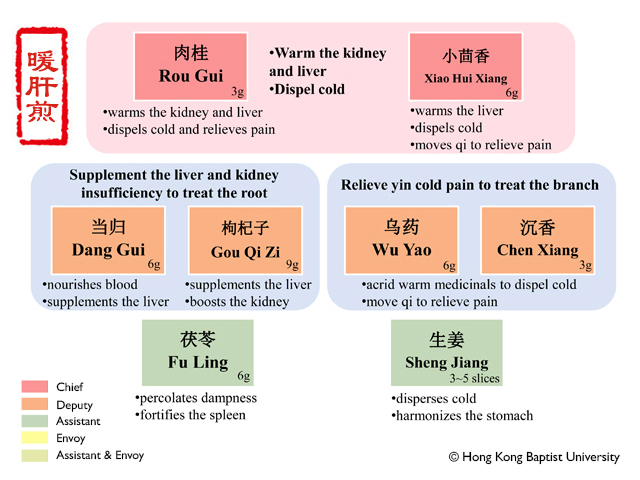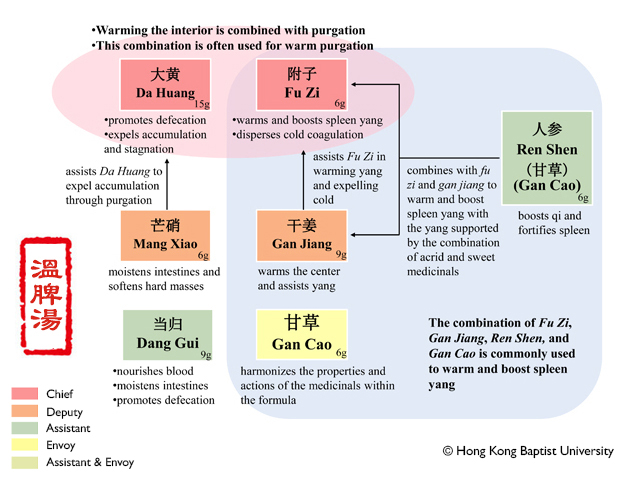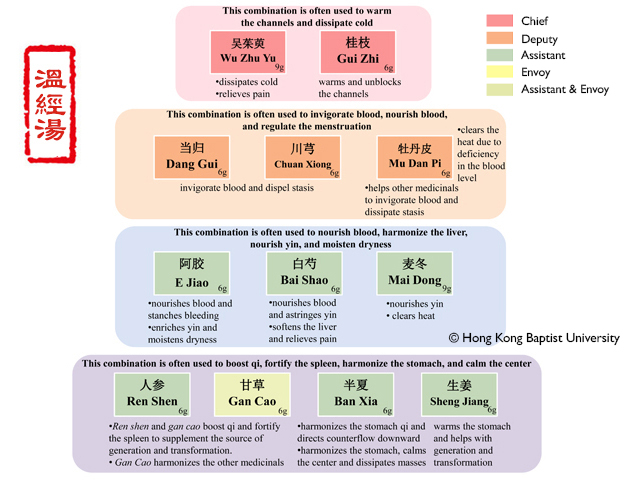| Numbering |
|
Name |
|
Combination |
|
Action |
|
Indication |
|
Thumbnail |
|
141
|
|
Yellow Dragon Decoction
|
|
Rhei Radix et Rhizoma; Natrii Sulfas; Aurantii Fructus Immaturus; Magnoliae Officinalis Cortex; Angelicae Sinensis Radix; Ginseng Radix et Rhizoma; Glycyrrhizae Radix et Rhizoma
|
|
Purges by promoting defecation, supplements qi and nourishes the blood.
|
|
This formula may be prescribed for yangming bowel excess with deficiency of qi and blood. This pattern is characterized by either the discharge of clear, watery stool that is pure green or constipation. There is stomach cavity and abdominal distention and pain which refuses pressure, fever, thirst, mental fatigue, shortness of breath, delirious speech, picking at their pajamas, teasing air as if arranging thread, unconsciousness, reversal counterflow cold of the four limbs, a dry yellow or dry black tongue coating, and a weak pulse.
|
|

|
|
142
|
|
Liver-Warming Decoction
|
|
Angelicae Sinensis Radix; Lycii Fructus; Poria; Foeniculi Fructus; Cinnamomi Cortex; Linderae Radix; Aquilariae Lignum Resinatum
|
|
Warms and supplements the liver and kidney, moves qi and relieves pain.
|
|
Nuan Gan Jian is indicated for patterns of liver and kidney insufficiency with cold coagulation in the liver channel. Symptoms include cold pain in the testis, lower abdominal pain, fear of cold, and a preference for warmth. The tongue is pale with a white coating, and the pulse is deep and slow.
|
|

|
|
143
|
|
Spleen-Warming Decoction
|
|
Rhei Radix et Rhizoma; Angelicae Sinensis Radix; Zingiberis Rhizoma; Aconiti Lateralis Radix Praeparata; Ginseng Radix et Rhizoma; Natrii Sulfas; Glycyrrhizae Radix et Rhizoma
|
|
Expels cold accumulation through purgation, warms and supplements spleen yang.
|
|
Wen Pi Tang is indicated for cold accumulation due to yang deficiency. Symptoms are abdominal pain and constipation, unstoppable colic around umbilicus, cold hands and feet, a white tongue coating with no thirst, and a deep wiry, slow pulse.
|
|

|
|
144
|
|
Channel-Warming Decoction
|
|
Euodiae Fructus; Angelicae Sinensis Radix; Paeoniae Radix Alba; Chuanxiong Rhizoma; Ginseng Radix et Rhizoma; Cinnamomi Ramulus; Asini Corii Colla; Moutan Cortex; Zingiberis Rhizoma Recens; Glycyrrhizae Radix et Rhizoma; Pinelliae Rhizoma; Ophiopogonis Radix
|
|
Warms the channels and dissipates cold, dispels stasis and nourishes blood.
|
|
Wen Jing Tang is indicated for deficiency-cold of the chong and ren mai, obstructive blood stasis marked by menstrual spotting or purple menses with blood clots. There may be irregular menstruation such as advanced, delayed, or prolonged periods, or having a period twice a month. There may also be inhibited menses, fever at night, vexatious heat in the palms, dry lips and mouth, distention and fullness of the lower abdomen, a dark red tongue, and a thready, choppy pulse. Infertility due to deficient cold of the uterus may also manifest.
|
|

|

